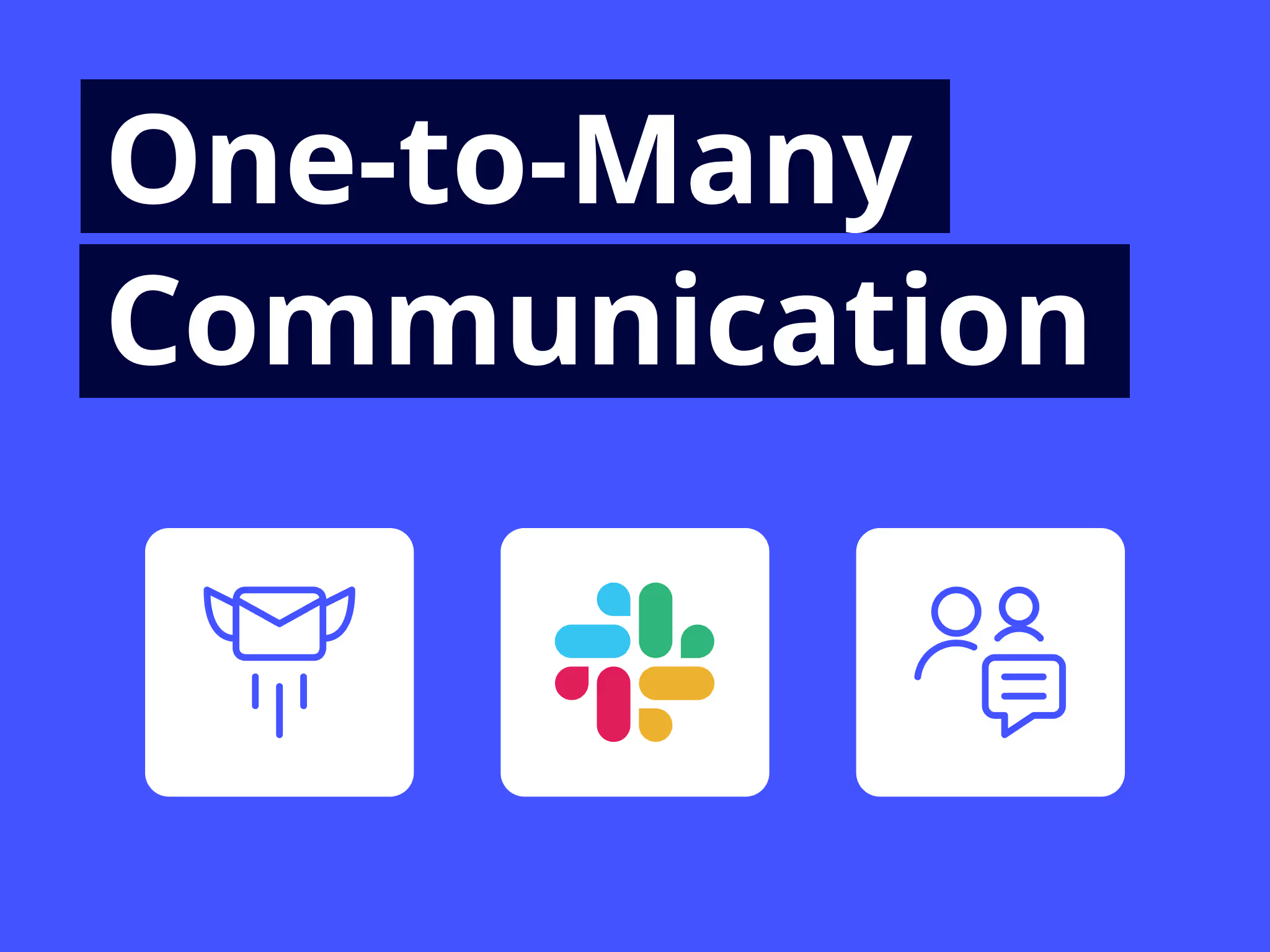As an influencer marketer, you’re a pro at building relationships. But negotiating with creator partners can make you feel like you’re risking those relationships because you’re trying to keep influencers happy while also securing the best possible deal for your brand.
Should you lay all your cards on the table and share your budget? Or wait for their anchor rate? What if the influencer refuses to engage if you lowball them too much? 🤯
To help you navigate that inevitable conversation with an influencer, here are seven tips and strategies for negotiating pricing – while being fair and keeping everyone happy.
❗Before we begin: this article isn’t a guide to underpaying influencers.
Content creation is hard work, and influencers should be compensated fairly for their efforts. Your mission isn’t to get the highest possible volume of content for the lowest possible cost – it’s to reach a deal that 1) fits your budget and 2) gives the influencer enough time and motivation to create fantastic content for your campaign.
Now that we’re clear, let’s get into it! 👇
1: Bundle deliverables to reduce the price of each
The single most popular influencer negotiation tactic is to bundle multiple deliverables in a single collaboration. In fact, it’s so popular that when we interviewed 38 influencer marketers about price negotiation, over 90% said they leverage bundling.
(Psst, 60% also said they never receive pushback when proposing bundle deals, which suggests influencers are open to bundling deliverables.)
The premise is simple: the influencer quotes you a rate for deliverable X, then you ask if they could bundle in deliverables Y and Z for the same amount. That way, the influencer gets their desired fee, and you get more content at a lower price per deliverable. Everyone wins 🏆
Another benefit of using this tactic is that it boosts your campaign reach when you bundle deliverables for multiple platforms, such as bundling a TikTok video with an Instagram Reel.
Of course, not all deliverables are a good fit for bundling – typically, short-form content is easiest for this strategy.
For instance, an influencer could feasibly create a couple of Story frames in an hour, making them comparatively affordable, whereas a dedicated YouTube video could require days of scripting, filming, and editing.
So it’s no surprise to see that Instagram Stories are the most popular bundled deliverables, closely followed by Reels, while YouTube videos are way down the list.

Fernanda Marques says negotiating bundle deals is all about balancing reach, engagement, and impact to get the best possible value from each collaboration.
2: Consider negotiating a "minimum view guarantee"
If bundling deliverables is straightforward, then negotiating a minimum view guarantee is more complicated.
With a minimum view guarantee (MVG), you ask an influencer to achieve a certain number of views on a piece of video content – say, 20K views on a sponsored Reel. It’s easy to imagine why brands are keen to push this type of deal: it removes some of the risk of influencer marketing by guaranteeing a minimum number of eyes on their content.
However, I’m here to tell you that minimum view guarantees are actually a bad thing because there’s no real guarantee.
Much as they’d like to, your influencer partners don’t control The Algorithm™. They might create a superb piece of content that checks every box in your influencer brief, but for whatever reason, it just doesn’t hit your view target. C’est la vie 🤷
Almost 60% of influencer marketers we surveyed said they never use MVGs, while nearly 75% who have used them said that proposing a minimum view guarantee had discouraged an influencer from working with their brand.
For that reason, Namrata Thakker says she reserves this negotiation tactic for the most expensive influencers with the largest followings.
“We only use minimum view guarantees when we work with a category A+ macro influencer. Because the stakes are so high, it’s imperative for us to get a minimum view guarantee in return to justify the high investment.” – Namrata Thakker
If, like Namrata, you can’t afford not to impose an MVG, bear in mind there are two different “flavors” of guarantee:
🥕 The carrot, which incentivizes the influencer to hit your view target by offering additional rewards like a higher flat fee, increased commissions, or a long-term partnership.
👊 The consequence, which penalizes the influencer if they fail to reach the desired number of views, such as demanding a lower fee or extra deliverables.

Admittedly, the “carrot” approach feels way less… icky… than that of the “consequence.”
It gets the relationship off to a positive start and gives the influencer real motivation to reach and exceed your view targets. And you know what they say: you can catch more flies with honey than vinegar 🍯
3: Offer performance bonuses with lower fixed fees
POV: You find the perfect influencer, tell them what deliverables you’re looking for, and ask them for a quote. Unfortunately, they come back with a fee that’s out of budget. Shoot.
But all is not lost – you can still win them over with a performance-based bonus. It won’t work for every influencer, but many will agree to a slightly lower fixed fee in exchange for a chance to unlock higher earnings if they hit a certain target.
Indeed, just over half of respondents to our survey said they’ve negotiated with influencers by combining fixed fees with performance-based incentives – typically, a percentage of sales.
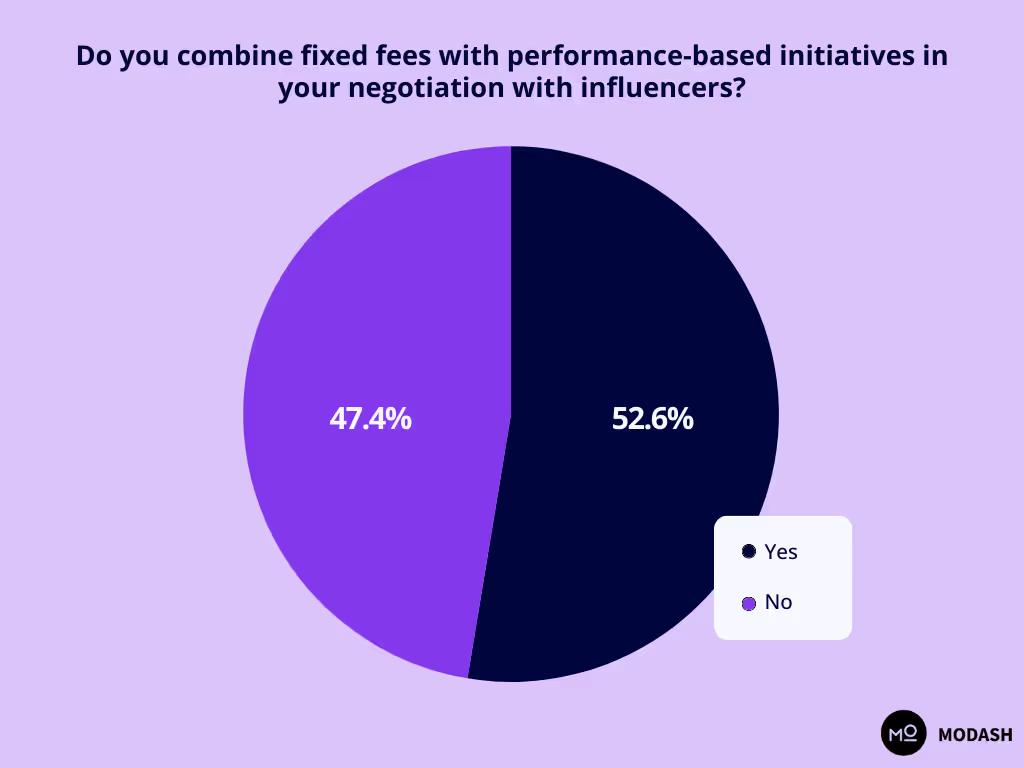
So how does this negotiation tactic work in practice?
Let’s say you agree on a rate of $300 per deliverable. Then, when your influencer partner hits $300 in revenue, you offer them a 10% cut of all subsequent sales they generate.
On the downside, this approach adds an extra layer of complexity to your invoicing process – but if it helps you sign an in-demand influencer with a highly relevant audience and who would otherwise have been too expensive, it’s likely worth the effort.
Nacho Selma says positioning is important when using performance-based bonuses as a negotiation tactic.
4: Negotiate the scope of work instead of the influencer rate
I’ve already discussed using bundle deals to get more bang for your influencer marketing buck.
But that’s not the only way to negotiate greater value. For example, if the influencer can’t (won’t) reduce the price, try asking them to:
👉 Remove exclusivity
👉 Create a less expensive deliverable
👉 Reduce/remove influencer usage rights
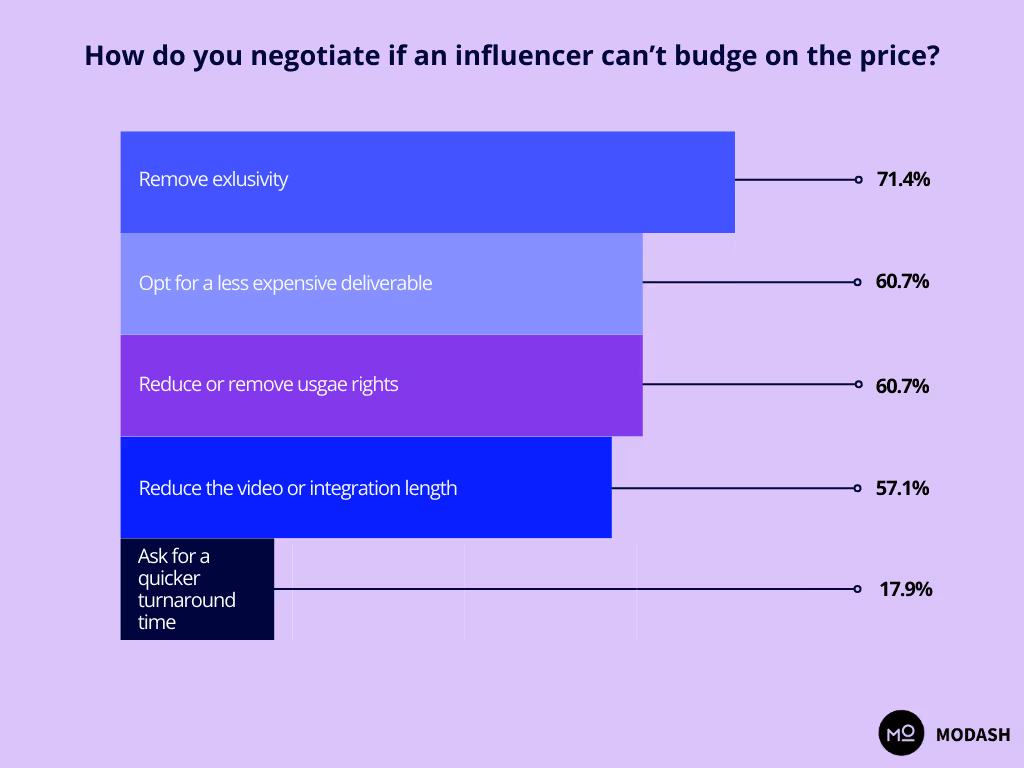
A quick note about usage rights: because they can seriously drive up costs, Greta Zacchetti recommends ignoring them in the early days of an influencer relationship.
Though some (more aggressive) negotiation tactics can damage your relationship with an influencer before it’s even begun, negotiating on value is lower-risk.
Indeed, three-quarters of respondents to our survey said influencers are generally receptive to renegotiating deliverables to reduce the overall price, while only one-third said this approach had put an influencer off working with their brand.
5: Propose a longer-term collaboration
Plenty of businesses sweeten the pot in return for a longer deal.
Like how deodorant brand Duradry gives customers a 15% discount for choosing a subscription over a one-time purchase:
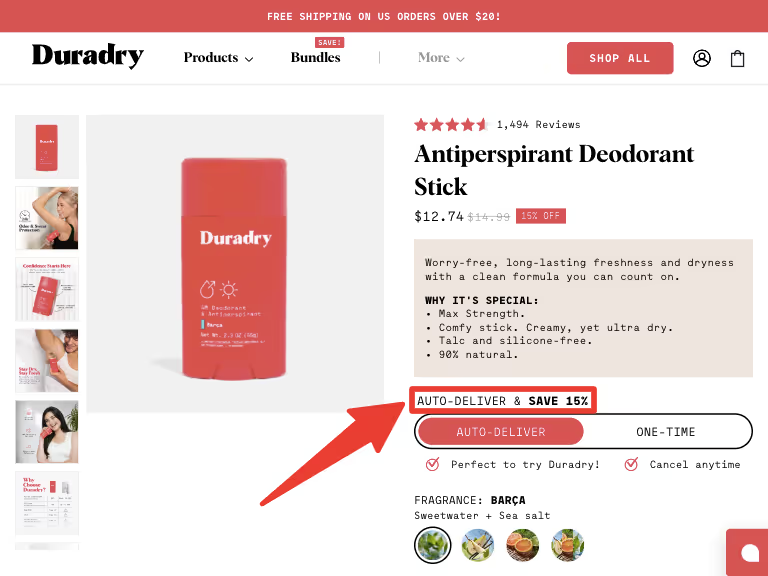
You can use this same principle in your negotiation by asking the influencer for a discount in exchange for a long-term contract.
Why would an influencer agree to lower their price in exchange for a long-term contract? There are three reasons:
✅ It gets easier for them to create different assets for the same brand because they understand your expectations
✅ Influencers love the stability of knowing where their next paycheck is coming from
✅ Consistent partnerships with one brand look more authentic on their feed
It’s also a great deal for you because:
👍 Partnering with the same influencer means less time spent finding new influencers and managing influencer relationships
👍 You gain visibility and build trust with a new audience because an influencer posts about you consistently
How do you offer a long-term collaboration if the influencer demands a higher fee? Tweak this template:
“Hey {influencer name}, we love working with you and would be ecstatic to continue our collaboration. Currently, our budget is $XXX for {the type of deliverables you’re expecting from the influencer}, but we’d like to find a way to continue working with you. At that rate, we’re happy to commit for a longer period. We can sign a contract of X months to begin with. What do you think?”
Have an open and honest conversation with the influencer about your budget and expectations. Don’t be afraid to renegotiate with other perks – like free products – if the long-term contract alone doesn’t cut it for them.
⚠️ Remember: Only offer long-term influencer contracts to partners you enjoy working with and who generate a strong ROI. You don’t want to get tied to a six-month contract with an influencer who doesn’t produce tangible results.
6: Use influencer analysis tools for data-backed negotiation
You’ve found an influencer who looks like they’d be a great brand fit 🎉
Before you go writing them a blank check though, it’s still worth it to assess their potential value as a partner. They might look ideal from the outside, but maybe their audience is still growing or doesn’t totally align with your ICP. Or perhaps their sponsored content performance is hit-and-miss. Whatever the case, you need to negotiate to make the partnership worthwhile.
Trouble is, you don’t know any of that stuff without data. There are two ways to get the numbers you need to make informed negotiation decisions:
👉 Ask the influencer in question to send screenshots of their audience and/or performance metrics
👉 Find it yourself using an influencer analysis tool like Modash

As you can see, option #2 is much more efficient – especially when you’re recruiting influencers at scale.
Modash gives you access to a whole world of influencer and audience data, including:
👉 Audience demographics (age, gender, location, etc.)
👉 Audience interests and brand affinity
👉 Past sponsored content performance
👉 Engagement rate
👉 Fake follower percentage
All of which can inform your negotiation strategy. (Or, after taking a closer look at the numbers, you might decide that influencer wasn’t such a good fit after all.)
⚠️ Try Modash’s influencer analytics tools – and all our other features! – by signing up for your free trial, no credit card details required 🙅
7: Provide non-monetary rewards instead of higher fees
If you have a tight influencer marketing budget, I have excellent news: money isn’t the only incentive in your toolbox.
You think Rihanna performed at the Super Bowl for free just cuz ✨ tradition ✨? Nah. She did it for her brand, Fenty Beauty – which reportedly earned $5 million in media impact value in just 12 hours after the performance.
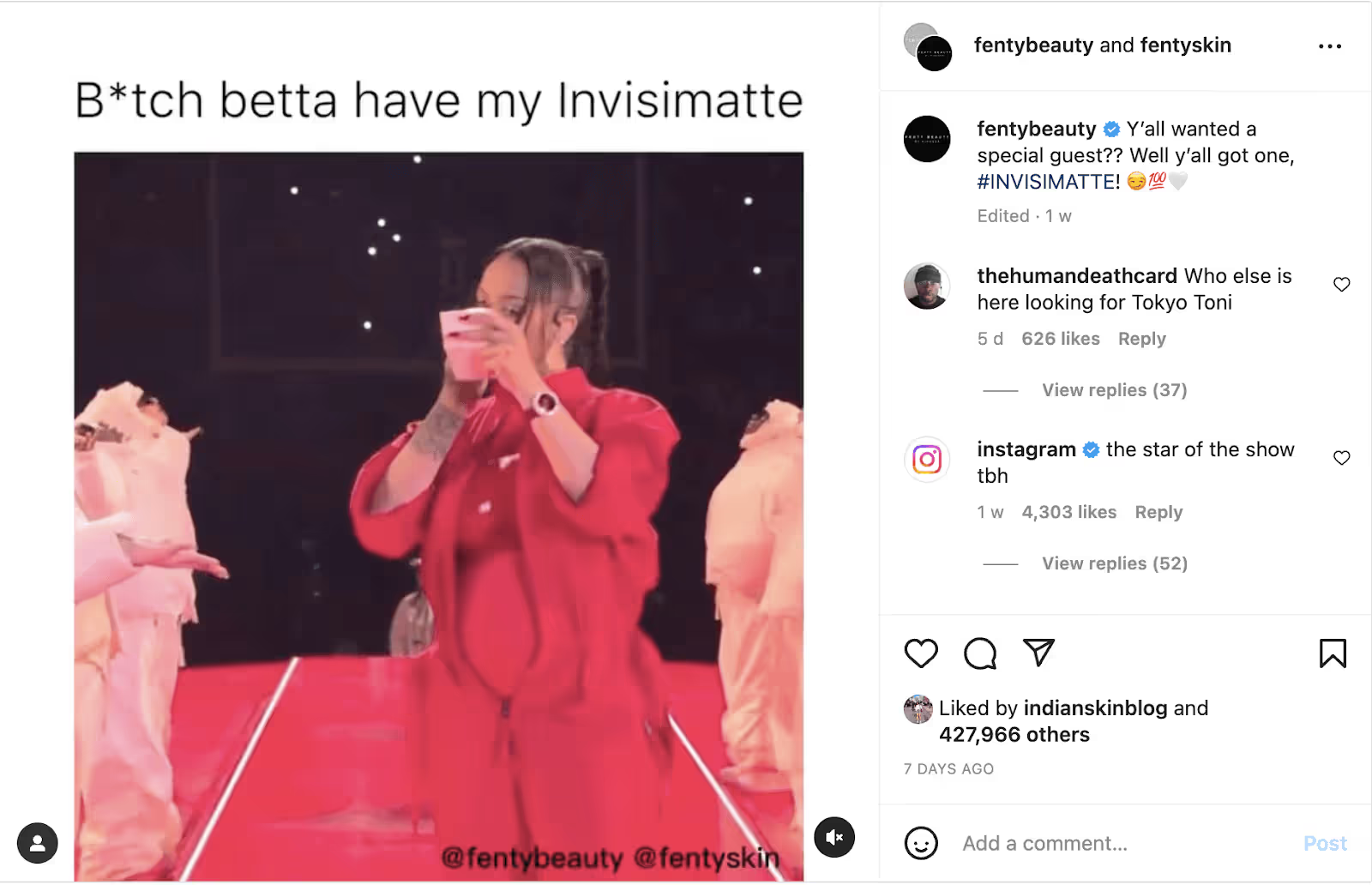
There are plenty of ways to pay influencers – and not all have to be some moolah in their wallet.
For instance, beyond fixed compensation and affiliate-style commissions, Fernanda Marques offers influencer partners exposure on her company’s YouTube channel, which has 20 million loyal subscribers. Other non-financial negotiation tactics she uses include event invites and costume sponsorships.
Other ideas for non-financial rewards include:
👉 Gifting products and merchandise
👉 Paying travel expenses for the campaign
👉 Providing early access to new product launches
👉 Promoting their content in your company newsletter
👉 Sending your own film crew to take some of the production burden off their to-do list
Final thoughts
I’ve got good news for you:
You don’t need to listen to 10,000 hours of business podcasts or read a million posts from LinkedInfluencers to master the art of influencer negotiation 🙏
In reality, there are no tricks or shortcuts to getting it right – it’s as simple as treating influencers with respect and being transparent. Whether you propose a bundle deal, a long-term partnership, or non-monetary incentives, there are plenty of ways to negotiate a better price without anyone feeling slighted.
And if, after all that, you can’t reach an agreement that keeps everyone happy, it’s fine to move on. There are plenty more fish in the sea.


.avif)





